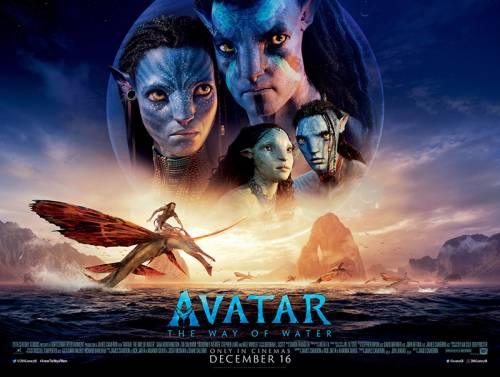Susan Granger’s review of “Avatar: The Way of Water” (20th Century Studios/Disney)
It’s been 13 years since James Cameron’s “Avatar” was released. And it’s well worth the wait to see his $350 million “Avatar: The Way of Water,” demonstrating how he uses cinematic technology to create a new, fantastical Na’vi realm on a distant moon called Pandora.
After his human form was killed, Colonel Miles Quaritch (Stephen Lang) is resurrected as a 10’ tall Na’vi avatar. On assignment from the Resources Development Administration (RDA), he’s determined to colonize Pandora as a replacement for the dying Earth with the help of his recombinant Marine buddies.
What Quaritch doesn’t realize is that he left behind a human son, Spider (Jack Champion), who has become part of soldier-turned-liberator Jake Suilly (Na’vi-ized Sam Worthington) and Neytiri’s (Zoe Saldana) family, along with teenage Kiri (Sigourney Weaver), daughter of late RDA scientist, Dr. Grace Augustine (also Weaver); Kiri has a mystical connection with the Na’vi deity Eywa.
Together with these two adoptees, Sully & Neytiri have three biological Omaticaya children: eldest son Neteyam (Jamie Flatters), younger Lo’ak (Britain Dalton) and daughter Tuk (Trinity Jo-Li Bliss).
Fleeing from villainous Quaritch and his treacherous ‘sky people,’ they take refuge on Awa’Atulu with Chief Tonowari (Cliff Curtis) and his pregnant wife Ronai (Kate Winslet). The reef-dwelling Metkayina are an aquatic clan who introduce them to an underwater world with bioluminescent vegetation. That’s where Lo’ak befriends an outcast Tulkun (a gigantic, super-intelligent whale-like creature).
(The forest Na’vi has pale blue skin, luminescent freckles and thin tails, harmonious with their natural world, while the Metkayina’s skin is more turquoise with thicker, finny tails to enable swimming.)
Working with James Cameron, screenwriters Rick Jaffa and Amanda Silver have developed an emotional arc for each motion-captured character. The result is compelling, fully digital sci-fi, highlighted by cinematographer Russell Carpenter’s dazzling visual effects, particularly the breathtaking deep-sea sequences.
FYI: The original “Avatar” (2009) is streaming on Disney+. Note this sequel has no post-credit scene, teasing future “Avatar” adventures, scheduled for 2024, 2026 and 2028.
On the Granger Gauge of 1 to 10, “Avatar: The Way of Water” swims in with a wondrous, visually stunning 10 – meant to be seen on the big screen.

